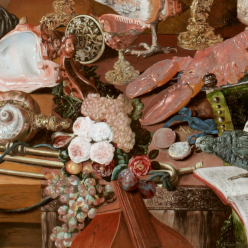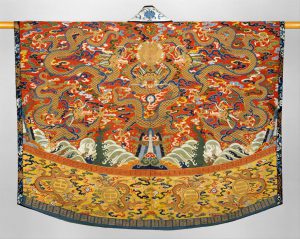
1690
Silver metalwork and cowrie shell
The Metropolitan Museum of Art; 68.141.278
Spices were at the heart of World commerce in the 17th century. It could be argued that the Dutch republic built itself a golden age on the spice trade. At the height of their power, the Dutch had a monopoly on the world’s supply of nutmeg and mace as well as control over the vast majority of the the world’s access to cloves.
Part of the reason why the Dutch could maintain their nutmeg monopoly was because the nutmeg tree only grew on the Banda islands in Indonesia. Although efforts to cultivate the trees elsewhere generally proved futile, to protect their monopoly the Dutch would dip their nutmeg exports in lime. To further defend their monopoly, the Dutch maintained a heavy military presence on all of the Bandan isles. These stringent measures were enacted by the governor of the Dutch East Indies of the time, a man named Jan Pietersz Coen.
The seriousness with which Coen took the security around the Bandan isles was largely due to the fact that the Dutch were able to make a 7500% profit on each shipment of nutmegs. This was at least partly due to Coen’s especial ruthlessness. He coerced the headmen of tribes on each island to sign contracts that established the Dutch East Indies Company as the sole beneficiary of their Nutmeg harvests, ratcheting down the prices for their labor to be so low as to provoke widespread uprisings on the islands against his terms. Coen saw the uprisings as breach of contract and so declared war, eventually enslaving the native inhabitants of the islands to ensure steady production of nutmeg.
Although the Dutch had established their claim to the Banda Islands with an excessively blatant display of imperialism, in the eyes of the British, the westernmost Island in the archipelago, Pulo Run, was sovereign British territory. The Brits had reached the Bandas first in 1603 and had sent several subsequent, unsuccessful colonization attempts that had largely been thwarted by the Dutch.
Tensions over Pulo Run contributed to the outbreak of both Anglo-Dutch wars. Terms that required the return of Pulo Run to British ownership were expressly stated in the treaty of Whitehall of 1662 which marked the end of the first Anglo-Dutch war. Although the British attempted a return to claim the island, by the time they managed to launch an expedition, the second Anglo-Dutch war had begun and the Dutch once again prevented English occupation of the island. They had managed to keep their monopoly.
The treaty of Breda doesn’t expressly state the names of any territories. Britain and the United Netherlands (as Holland was then known) instead agreed that all territories that had been captured over the course of the war were to be be kept of by the captor. This was effectively a game of monopoly where the Dutch exchanged their colony of New Amsterdam on Manhattan Island in the American Northeast for the British territory on Suriname and the British claim to the Island of Pulo Run.
Such was the draw of the monopoly that Nutmeg offered. For the Dutch, Even though the entirety of their Nutmeg crop came from the the two main islands of Banda and Naira, they couldn’t allow the Brits the possibility of breaking their monopoly with the island of Pulo Run.
Sources:
Davenport, F.G., and C.O. Paullin. “Treaty of Friendship between Great Britain and the United Netherlands Concluded at Whitehall September 4/14 1662.” In European Treaties Bearing on the History of the United States and Its Dependencies, 73–85. Carnegie Institution of Washington Publication. Lawbook Exchange, 2004. https://books.google.com/books?id=mDPF4ILESaUC.
———. “Treaty of Peace and Alliance between the United Netherlands and Great Britain, Concluded at Breda, July 21/31, 1667.” In European Treaties Bearing on the History of the United States and Its Dependencies, 73–85. Carnegie Institution of Washington Publication. Lawbook Exchange, 2004. https://books.google.com/books?id=mDPF4ILESaUC.
Donkin, R.A. Between East and West: The Moluccas and the Traffic in Spices Up to the Arrival of Europeans. Memoirs of the American Philosophical Society. American Philosophical Society, 2003. https://books.google.com/books?id=-AdJrE5RDvYC.
Keay, J. The Spice Route: A History. John Murray, 2006. https://books.google.com/books?id=D3m3MgEACAAJ.
Michael Krondl. “The Company Man.” In The Taste of Conquest; The Rise and Fall of Three Great Cities of Spice. New York: Ballantine Books, 2008.
Milton, G. Nathaniel’s Nutmeg, Or, The True and Incredible Adventures of the Spice Trader Who Changed the Course of History. Farrar, Straus and Giroux, 1999. https://books.google.com/books?id=4fyKAwAAQBAJ.
Penny Le Couteur, Jay Burreson. “Peppers, Nutmeg, and Cloves.” In Napoleon’s Buttons; How 17 Molecules Changed History, 19–35. New York: Penguin Putnam Inc., 2003.
Swart, Koenraad Walter. The Miracle of the Dutch Republic as Seen in the Seventeenth Century: An Inaugural Lecture Delivered at Univ. Coll. London, 6 Nov. 1967. Lewis, 1969.

